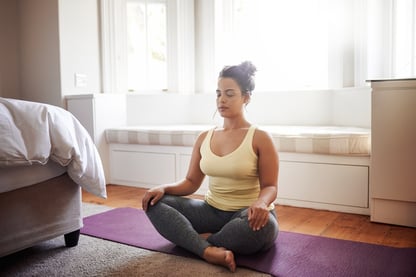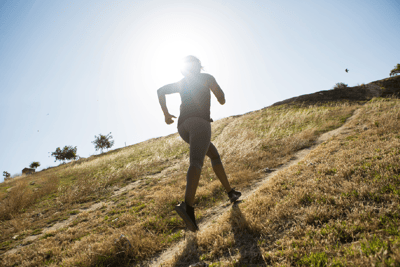 Getting healthy and losing weight go hand in hand. If your goal is to get healthy and lose weight, I need you to RELAX! No, really! Relaxing is good for you, and managing stress effectively doesn’t only help with weight loss; it makes us healthier overall. So sit back, relax, and read on for more tips.
Getting healthy and losing weight go hand in hand. If your goal is to get healthy and lose weight, I need you to RELAX! No, really! Relaxing is good for you, and managing stress effectively doesn’t only help with weight loss; it makes us healthier overall. So sit back, relax, and read on for more tips.
How Cortisol Plays a Role
Cortisol is a hormone that your body releases when it is stressed. If you only have small amounts of cortisol, there is no problem. But when stress is constant, as it can be in many of our lives, the amount of cortisol in your bloodstream rises and stays elevated. This all leads to weight gain. Relaxation can help prevent overproduction of cortisol.
When cortisol is released, those cravings for potato chips, candy bars, pastries, and so on are what provide a quick energy boost. As if those choices aren’t bad enough, cortisol goes on to store those extra calories as fat, mainly around your abdominal area. There is also the interference with hormones that control your appetite. You will start to find that you are hungry more often and have a hard time staying satiated.
And if that doesn’t make you want to stop stressing, cortisol can also cause decreased muscle mass because it lowers testosterone levels. The lower your muscle mass, the less fat you will burn when working out.
Ways to Relax
Here are five tips for relaxing.
- Meditate. This is an excellent method for cleansing your mind of all the negative and stressful thoughts. Refresh and think positively. Whenever you feel heavy or burdened, or even when you feel tired of doing work, take a deep breath and allow your body to relax. Really focus on your breathing by using a 5 count: Breath in for a count of 5. Hold your breath for a count of 5. Release that breath for a 5 count. Try this a few times a day.
- Avoid distractions. To fully relax your lifestyle and live a stress-free life, limit all distractions, such as television, cell phones, or laptops.
- Become more active. Exercise alone can be the best stress reliever. Try grabbing a friend for a walk/jog outside in the fresh air. Take a new group fitness class like the various types of yoga classes NIFS offers. Join a small group where you can laugh, work, and have fun with goal-oriented individuals, or have a Health Fitness Instructor design a program dedicated to your needs. The possibilities are endless.
- Eat healthy. Like regular exercise, eating a healthy, balanced diet can make a significant contribution to a less-stressful lifestyle. By making healthy eating choices, you can make yourself both physically and emotionally stronger. Eat vegetables, drink plenty of water, and control your portions. Not sure about where to start with your nutrition? Meet with one of our Registered Dietitians to get you going on the right path. If you want the whole package of eating healthy and exercising, check out our Ramp Up to Weight Loss program.
- Get enough sleep. The average adult requires between 7 and 9 hours of sleep per night. Not only can lack of sleep lead to increased stress, but chronic sleep deprivation can impair your judgment, reasoning ability, appearance, and performance at work. Start by establishing a daily sleep schedule. Do something relaxing before bed and turn off electronic devices.
It would be wonderful if we could constantly live in a vacation state, but for most of us that’s not quite possible. By utilizing just a couple of these resources, you help not only your body get to a better state, but your mind as well, which in turn allows for weight loss to occur.
This blog was written by Ashley Duncan, Weight Loss Coordinator. To find out more about the NIFS bloggers, click here.


 Fitness is a great tool to use to train the mind. Yes, often people work out for physical health, but exercise is also getting a lot of
Fitness is a great tool to use to train the mind. Yes, often people work out for physical health, but exercise is also getting a lot of 
 Can you remember preschool when the teacher would turn down the lights and break out the cots? Nap time! You might not have had that exact experience, but as humans we are prone to napping. In our go-go-go life, time is money. To society, sleeping during the day is seen as a luxury that we cannot provide ourselves, and is usually thought of as a sign of laziness.
Can you remember preschool when the teacher would turn down the lights and break out the cots? Nap time! You might not have had that exact experience, but as humans we are prone to napping. In our go-go-go life, time is money. To society, sleeping during the day is seen as a luxury that we cannot provide ourselves, and is usually thought of as a sign of laziness. A few summers back, I spent 5 fantastic days in Maui with my wife and her family, and as you can probably imagine, I had the best time of my life there! I have been so lucky to be included on my wife’s family vacations and have had the opportunity to visit some amazing places, each one better than the last. For that, I am extremely thankful!
A few summers back, I spent 5 fantastic days in Maui with my wife and her family, and as you can probably imagine, I had the best time of my life there! I have been so lucky to be included on my wife’s family vacations and have had the opportunity to visit some amazing places, each one better than the last. For that, I am extremely thankful! When it comes to settling back into school, adjusting to the crazy schedule can become one of the biggest tasks. From classes each day, to group project meetings, to homework due dates and the dreaded semester exams, how are we supposed to find the time to keep ourselves healthy and fit?
When it comes to settling back into school, adjusting to the crazy schedule can become one of the biggest tasks. From classes each day, to group project meetings, to homework due dates and the dreaded semester exams, how are we supposed to find the time to keep ourselves healthy and fit?  There are so many things in life that can affect different aspects of the human body, and stress is one of the biggest! During a stressful time in life, the body can undergo several physiological changes that can be detrimental to your overall health. Though sometimes we cannot avoid certain stressors that fall into our path of life, there are some things that can be done to help you cope during those times.
There are so many things in life that can affect different aspects of the human body, and stress is one of the biggest! During a stressful time in life, the body can undergo several physiological changes that can be detrimental to your overall health. Though sometimes we cannot avoid certain stressors that fall into our path of life, there are some things that can be done to help you cope during those times. 
 The light will begin to glow anywhere from 20 to 60 minutes prior to your set time to wake up (how hard you sleep will determine how much time you should have the light begin glowing). The light begins a reddish color to simulate the sun rising, and gradually becomes brighter and brighter until you wake up and turn it off. And if you were to sleep through the 20-minute light glow, you would be awakened by birds chirping.
The light will begin to glow anywhere from 20 to 60 minutes prior to your set time to wake up (how hard you sleep will determine how much time you should have the light begin glowing). The light begins a reddish color to simulate the sun rising, and gradually becomes brighter and brighter until you wake up and turn it off. And if you were to sleep through the 20-minute light glow, you would be awakened by birds chirping.  Are you having one of those days (or weeks, or months) where you feel like the gerbil on the wheel? You are going along just fine, and then a stressful situation crops up and you to need to spin the wheel faster. Soon, that’s not fast enough. When you finally realize you are going to be thrown off the wheel if you stop, it hits you: you’re exhausted. I get this way every few months.
Are you having one of those days (or weeks, or months) where you feel like the gerbil on the wheel? You are going along just fine, and then a stressful situation crops up and you to need to spin the wheel faster. Soon, that’s not fast enough. When you finally realize you are going to be thrown off the wheel if you stop, it hits you: you’re exhausted. I get this way every few months.
 individuals who only want to bring you back down to their level of unhappiness.
individuals who only want to bring you back down to their level of unhappiness.

